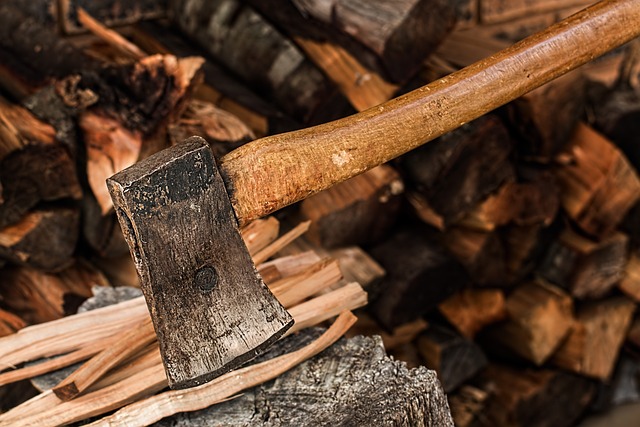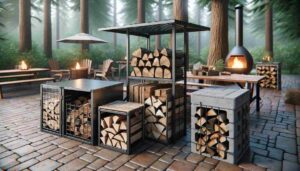Today, I’m going to dive into the topic of firewood and explore a burning question: Is alder wood a good option for fueling those cozy fires? As someone who appreciates the warmth and comfort of a well-stoked fire, I’ve done some digging to bring you the lowdown on alder wood as a firewood choice.
Yes, alder can be considered good firewood. While it may not match the heat output of denser hardwoods, alder wood provides a respectable level of warmth. It ignites easily, produces a pleasant aroma when burned, and can create a cozy ambiance. However, it burns relatively quickly, so it’s more suitable for shorter fires or occasions when a quick burst of warmth is desired.
But that’s not all, keep reading and discover the benefits, considerations, and much more of using alder wood for burning.
Understanding Alder Wood
When it comes to firewood, it’s important to understand the characteristics of different types of wood. So, let’s start by getting to know alder wood a little better.
Alder wood comes from the alder tree, a deciduous tree commonly found in North America and Europe. It is known for its light color, ranging from pale yellow to light brown, and its relatively soft texture. Compared to some other types of firewood, alder wood is not as dense, which can affect its burning properties.
Visually, alder wood has a distinct grain pattern and a smooth texture. It is often easy to identify due to its light color and occasional reddish undertones. In terms of density, alder wood is considered to be of medium density, which influences how it burns and the heat it produces.
Properly seasoned firewood is crucial for efficient burning. Alder wood generally has a higher moisture content when freshly cut, so it requires adequate drying or seasoning before use. The seasoning process helps reduce the moisture content, allowing the wood to burn more efficiently and produce more heat.
It’s important to note that when using alder wood as firewood, you’ll want to ensure it is properly seasoned to maximize its burning potential and avoid excessive smoke or difficulty in igniting the fire.
Let’s explore the advantages and considerations of using it as firewood.
Advantages of Burning Alder Wood
Now that you’re familiar with the characteristics of alder wood, let’s delve into the advantages it offers as a firewood option.
1. Good Heat Output: Despite being a relatively softwood, alder wood can still produce a significant amount of heat when burned. It has a respectable heat output, making it suitable for keeping your space warm and cozy. While it might not match the heat output of denser hardwoods, alder wood still provides a comfortable level of warmth.
When compared to other softwoods like pine or fir, alder wood generally produces more heat, making it a preferable choice for those seeking a balance between heat output and ease of burning.
2. Ease of Ignition: One of the fantastic qualities of alder wood is its ease of ignition. It readily catches fire, making it ideal for quickly starting and maintaining a fire. Whether you’re lighting up a fireplace, wood stove, or fire pit, alder wood ignites relatively easily, reducing the hassle and frustration of getting your fire going.
With alder wood, you won’t need to spend excessive time coaxing the flames; it’s a reliable choice when you want a fire that starts promptly.
3. Pleasant Aroma and Smoke: Imagine the inviting scent of a crackling fire filling the air around you. Alder wood is known for its pleasant aroma when burned. The smoke produced by alder wood has a subtle, sweet fragrance that adds to the overall ambiance of your indoor or outdoor space.
The fragrant smoke from alder wood can create a delightful atmosphere during your gatherings, enhancing the enjoyment of your time spent around the fire.
Considering these advantages, it’s clear that alder wood has its merits as firewood. However, there are also some considerations and limitations to keep in mind. Let’s explore those next.
Considerations and Limitations
While alder wood offers several advantages as firewood, it’s important to consider some limitations and factors that may influence your decision. Let’s take a closer look:
1. Fast Burning and Low Burn Time: One aspect to keep in mind is that alder wood tends to burn relatively quickly compared to denser hardwoods. Due to its lower density, alder wood may not provide a long-lasting fire if you’re looking for extended periods of heat. This makes it more suitable for shorter fires or occasions where a quick burst of warmth is desired.
If you’re planning for a cozy, shorter fire experience, alder wood can be an excellent choice. However, for longer fires or sustained heating needs, you may want to consider alternative firewood options.
2. Moderation for Cooking Purposes: If you enjoy cooking over a wood fire or using a wood-burning stove for culinary purposes, it’s worth noting that alder wood has a distinct flavor that can infuse into the food. While some people appreciate the mild smoky flavor alder wood imparts, it’s important to use it in moderation.
Excessive use of alder wood for cooking may overpower the natural flavors of the food. So, if you plan to cook with firewood, it’s recommended to balance the use of alder wood with other woods known for their culinary properties, such as fruitwoods or hardwoods like oak or hickory.
3. Comparisons with Other Firewood Types: When considering firewood options, it’s helpful to compare alder wood with other types, such as hardwoods and softwoods, to understand their respective pros and cons.
Hardwoods like oak, maple, or birch are known for their long burn times and high heat output. They are excellent choices if you require a sustained, high-temperature fire. Softwoods like pine or fir, on the other hand, ignite easily but may burn faster and produce less heat compared to alder wood.
Ultimately, the choice between alder wood and other firewood types depends on your specific needs, preferences, and the availability of different options in your area.
Next, let’s explore some tips for obtaining and using alder firewood to optimize your burning experience.
Tips for Obtaining and Using Alder Firewood
Now that you’re familiar with the advantages and considerations of using alder wood as firewood, let’s explore some tips to help you make the most of your alder firewood experience.
Sourcing Alder Wood
- Local Suppliers: Start by checking with local firewood suppliers, as they often carry a variety of wood types, including alder. They can provide you with properly seasoned and quality firewood.
- Online Resources: Explore online platforms that connect firewood sellers with buyers. This can be a convenient option if you have difficulty finding alder wood locally.
When sourcing alder wood, inquire about its moisture content and ensure it has been properly seasoned for optimal burning performance.
Storing and Seasoning Alder Wood
- Dry Storage: Once you acquire alder wood, store it in a dry and well-ventilated area. A covered woodshed or stack it off the ground with a tarp to protect it from moisture.
- Proper Seasoning: If the alder wood you obtain is not fully seasoned, allow it to air dry for at least 6-12 months. This duration may vary based on the initial moisture content and local climate. Aim for moisture content of around 20% for efficient burning.
Best Practices for Burning Alder Wood
- Proper Fire Building: Arrange the alder wood in a way that promotes good airflow for optimal combustion. Start with small kindling and gradually add larger pieces.
- Preheating: For easier ignition, preheat the flue or chimney by lighting a small piece of newspaper or using fire starters.
- Safety Precautions: Always follow standard fire safety practices, such as using a fireplace screen, keeping a fire extinguisher nearby, and ensuring proper ventilation.
FAQs (Frequently Asked Questions)
Q: Why should I not burn alder wood?
A: While alder wood has its advantages, it may not be suitable for everyone’s needs. It burns relatively quickly, making it less ideal for longer fires or sustained heat. Additionally, its lower density may result in less heat output compared to denser hardwoods. Consider your specific requirements before choosing alder wood as your primary firewood.
Q: Is alder good wood for a fireplace?
A: Yes, alder wood can be a good choice for a fireplace. It ignites easily and produces a pleasant aroma when burned, creating a cozy ambiance. However, keep in mind that it burns relatively quickly, so it may be more suitable for shorter fires or occasions when a quick burst of warmth is desired.
Q: Is alder or fir better for firewood?
A: Both alder and fir can serve as firewood options, but they have some differences. Alder wood generally burns with higher heat output and has a pleasant aroma. Fir wood, on the other hand, may burn slightly longer and produce less ash. The choice between the two depends on your specific needs and availability in your area.
Q: Is alder or birch better for firewood?
A: Alder and birch are both viable firewood options, each with its own characteristics. Alder wood burns relatively quickly and has a pleasant aroma. Birch wood, on the other hand, burns longer, produces more heat, and tends to have a beautiful flame. The choice between alder and birch ultimately depends on your specific preferences and requirements.
Q: How long does it take to season alder firewood?
A: The seasoning time for alder firewood can vary depending on factors such as initial moisture content and local climate. On average, it may take approximately 6-12 months for alder wood to properly season. Properly seasoned alder firewood should have a moisture content of around 20% for efficient burning. Ensure adequate drying time before using alder firewood for optimal performance.
Q: Is alder wood expensive compared to other firewood types?
A: The cost of alder wood can vary depending on your location and availability. Generally, it is considered an affordable firewood option compared to some hardwoods. It’s always best to check with local suppliers or do some research to get accurate pricing information.
Q: Can I use alder wood for cooking and smoking?
A: Yes, alder wood is commonly used for smoking and grilling due to its pleasant aroma and mild flavor. It can impart a delicate smoky taste to your food. However, remember to use it in moderation, as excessive use may overpower the natural flavors of the food.
Q: How long does alder wood take to season?
A: The seasoning time for alder wood can vary depending on factors like initial moisture content and local climate. On average, it may take approximately 6-12 months for alder wood to properly season. Ensure the wood has a moisture content of around 20% for efficient burning.
Q: Can I mix alder wood with other firewood types?
A: Absolutely! Mixing alder wood with other firewood types can offer a balanced burning experience. Consider combining it with denser hardwoods for longer burn times and increased heat output. Experimenting with different wood combinations allows you to customize your fire based on your specific needs and preferences.
Q: Where can I find a reliable source of alder wood?
A: To find a reliable source of alder wood, start by checking with local firewood suppliers or online platforms that connect firewood sellers with buyers. Ensure the wood is properly seasoned and of good quality. Recommendations from friends or neighbors who have used alder wood can also be helpful.
Q: Can I burn freshly cut alder wood?
A: It is not recommended to burn freshly cut alder wood as it has a high moisture content. Proper seasoning is essential to reduce the moisture content and optimize the burning performance. Allow the alder wood to air dry for at least 6-12 months before using it as firewood.
Remember, firewood choices can vary based on personal preferences and regional availability. If you have further questions or concerns, it’s always beneficial to consult with local experts or experienced firewood users in your area.
Conclusion
In conclusion, alder wood can be a good option for burning, considering its advantages such as good heat output, ease of ignition, and a pleasant aroma. However, it’s important to be aware of its limitations, including its relatively fast burn time and the need for moderation in cooking applications. Comparing alder wood to other firewood types can help you make an informed decision based on your specific needs.
Remember to source properly seasoned alder wood, store it correctly, and follow best practices for building and maintaining your fire. With these tips in mind, you’ll be well-equipped to enjoy the warmth and coziness of alder wood fires.
So, go ahead and give alder wood a try! Embrace the crackling flames and the delightful scent, and let the magic of a well-stoked fire enhance your indoor or outdoor experiences.









